- 1Istituto Nazionale di Geofisica e Vulcanologia, Sezione di Bologna, Bologna, Italy
- 2Istituto Nazionale di Geofisica e Vulcanologia, Osservatorio Vesuviano, Napoli, Italy
- 3Istituto Nazionale di Geofisica e Vulcanologia, Osservatorio Etneo, Catania, Italy
- 4Istituto Nazionale di Geofisica e Vulcanologia, Sezione di Roma 1, Roma, Italy
- 5Istituto Nazionale di Geofisica e Vulcanologia, Sezione di Palermo, Palermo, Italy
- 6Istituto Nazionale di Geofisica e Vulcanologia, Sezione di Pisa, Pisa, Italy
Italy is the land of iconic volcanoes, whose activity has been witnessed, described and portrayed for centuries. This legacy has greatly contributed to shaping the public perception of volcanoes and their impact, well beyond the national borders. Stories about famous eruptions overlap and nowadays easily mix up with the impressive footage that is readily available from ongoing eruptions worldwide. As a result, the public discourse may flatten the wide spectrum of possible phenomena into an oversimplified sketch of volcanic eruptions and their impact, where all events seem equally probable and look alike. Actual volcanoes differ in size, eruption magnitude, state of activity, eruptive style, geographical position, and each is located within a specific social and cultural context. All these elements combine in defining the consequences of volcanic activity as well as in determining the severity of the damage and the size of the impacted area. How can we convey such a complexity to the general public? Can social media contribute to raise awareness and build a more resilient society? An effective hazard communication should propose a comprehensible yet realistic description of volcanic settings and provide adequate tools to recognize and understand the specific features of each phenomenon and volcanic area. As we write, two Italian volcanoes display persistent eruptive activity, while other two are going through unrest phases that started in 2012, at Campi Flegrei, and in late summer of 2021, at Vulcano Island. Other active volcanoes (Vesuvius, Ischia, Colli Albani, Lipari, and Pantelleria) have been dormant for tens, hundreds, or thousands of years. Communication in these different contexts also require different approaches that take into account the specific needs of local communities. Social media may provide a unique opportunity to quickly share relevant news and information. Yet, this type of communication has its challenges and volcano observatories can rarely rely on expert social media managers. Sharing experiences and lessons learned is a key to ensure the growth of the volcanological community and improve its ability to connect and engage local residents. Here we discuss the online communication strategies implemented by the Istituto Nazionale di Geofisica e Vulcanologia (INGV) since 2018 to inform Internet and social media users about volcanoes, volcanology, and ongoing volcanic activity, both in Italy and abroad. We describe the internal procedures that we developed and practiced and the experience gathered so far, during both quiet periods and a few volcanic crises. Our experience confirms previous indications about the importance of a steady online presence and suggests that public interest is not always easily predictable.
1 Introduction
Italy is a volcanic country, featuring the very volcanoes that lent their names to the international scientific nomenclature, such as Stromboli and Vulcano, and iconic volcanoes such as Vesuvius, whose famous eruptions have shaped the popular perception of volcanic activity for centuries. Italian active volcanoes display various states of activity, ranging from quiescence to persistent eruptions, and different eruptive styles, from effusive to explosive. With the exception of submarine volcanoes, all active volcanoes in Italy are surrounded by inhabited areas, with a population density ranging from less than 100 inhabitants per square kilometre on small volcanic islands, to more than 10,000 near Naples, which is among the highest population densities in Italy (De Lucia et al., 2021). In such a variegated context, informing the public about volcanic activity ranges from disseminating fun facts or interesting stories about volcanoes and volcanology to providing timely information on the ongoing activity during volcanic crises. This may require sharing unpleasant information in a tense environment. To further complicate the task, scientists usually lack a specific training in science communication, and may inadvertently burden their information with too many details, or with unclear technical jargon (Fearnley et al., 2018a). Despite these difficulties, the dissemination of timely and accurate information about volcanic activity is considered essential to raise awareness of the population (Dufty, 2015; Todesco, 2017; Fearnley et al., 2018a; Dallo et al., 2022). Thanks to the widespread use of social media, when an interesting or dangerous event occurs the news spreads out quickly, in a surge of contents where actual information combines and mixes with fake or click-baiting news. The information blast is always accompanied by pictures and video footage that may be totally unrelated to the event in question (Sennert et al., 2018). In such a context, the presence of reliable and multi-targeted sources of information, providing a steady and continuous flow of facts and news about the ongoing events, may work as a compass to navigate through the media storms that easily form around volcanoes and volcanic activity (Sennert et al., 2018). Since 2010, social media channels have been extensively used by emergency managers to spread warnings and coordinate disaster response and recovery actions, and increasingly more to promote public awareness across several hazards (Dufty, 2015). Despite the growing interest, social media communication may be challenging and its efficacy is difficult to assess. Approaches that proved valuable in a specific context may fail elsewhere, as the surrounding conditions (and the social media platforms) change. As we get accustomed with this new kind of institutional communication, we can learn by collecting first-hand experiences and communication approaches (Fearnley et al., 2018b). In this work, we present the experience gathered by INGV in handling communication on social media during both volcano emergencies and during quiet times.
INGV is the Italian government research institution that is in charge of the seismic and volcanic surveillance of the country. To improve its online presence, INGV established in 2018 the “INGVvulcani” working group, which is entirely devoted to the communication about volcanoes and volcanology. The group is composed of researchers with different scientific backgrounds who work in different INGV branches (Sezioni) distributed around the country and in particular in the two volcano observatories, located in Naples (Osservatorio Vesuviano) and Catania (Osservatorio Etneo). The main objective of INGVvulcani is to create and distribute general and reliable scientific information about volcanoes and their activity, as well as some breaking news about evolving volcanic phenomena. The group also shares the official communications posted on the institutional websites (www.ingv.it; www.ct.ingv.it; www.ov.ingv.it). INGVvulcani also aims at describing volcanological research and the monitoring activity carried out at INGV, introducing INGV researchers to the general public. Shared contents are prepared considering different targets and are disseminated through various channels, including a blog and well-known social media in Italy (Facebook, Twitter, Instagram, YouTube).
The public response confirmed the strong need for accurate information about volcanic activity in Italian. We could verify that people attention’s is not always easily predictable and that, during emergencies, detailed information may be more appreciated than videos or beautiful images. We monitor the basic analytics provided by social platforms but we do not consider them alone as a reliable indicator of the efficacy of our communication efforts. Based on our experience, we worked to maintain a steady flux of information and proposed a variety of contents, on various topics and characterized by different lengths and level complexity. Insight articles, in particular, convey basic volcanological knowledge and provide a sound framework for the interpretation of ongoing phenomena that is appreciated during volcanic crises. Our experience also confirms that traditional media closely follow the news published on social media channels, and easily relaunch contents about volcanoes and volcanic activity, especially if clear and concise and accompanied by high quality footage. Many of our followers contribute to disseminate information by sharing our posts.
2 The INGVvulcani Communication Strategy
Online communication takes advantage of many available channels to provide different kinds of information. In the creation and development of our communication channels and media we have taken into account the communication plans guidelines devised for Italian public administrations, which are inspired by the principles of transparency, i.e., the right to information in its many ways, document accessibility, and democratic participation of citizens, with particular attention to the delicate problem of the relationship between government and governance (Levi, 2004). The INGVvulcani communication strategy encompasses insight articles, periodically published on our thematic blog, and the publication of posts, images and video that allow us to describe volcanic phenomena as well as the research, monitoring and surveillance activities carried out by the Institute. In addition to producing and sharing the online information, INGVvulcani also collaborates in the outreach activities of INGV and provides information and support to the INGV press office for any matters that pertains volcanoes and volcanology, including the production of dedicated episodes of the INGV Geoscience web-news. The group may collaborate with other institutions to provide outreach contents about Italian volcanoes (De Lucia et al., 2021).
The kind of communication that we propose depends on the current situation. Communication about a dormant volcano, or during the quiet between eruptions, aims at establishing and maintaining the connection with the public, while disseminating general volcanological contents. Communication during volcanic crises, on the other hand, is designed to provide timely updates on event development, while providing the necessary background information that frames the events in their volcanological context (Table 1).
In both situations, the choice of contents to be shared has been carried out by the INGVvulcani editorial group, and was guided by the state of activity of our volcanoes, but also by topics that arise in the public conversation on social media, or in comments to our posts. Other features may intervene, such as the availability of colleagues who may propose photos, videos or written text to feed our channels. The personal experience of all group members, both as volcanologists and as science communicators, also influences the themes that are proposed. During these first few years of activity, this approach allowed us to create and set off the INGVvulcani social channels. A greater interaction with our public was limited by the lack of full-time, dedicated professionals. We are aware that a greater public engagement is the key to effective communication. We already worked with schools in the Neapolitan areas to investigate kids’ mental models of explosive eruptions and gained useful hints on how to design future outreach products (Todesco et al., 2022). We hope that in the future we will be able to propose more ambitious projects to involve local communities and practice the co-production of volcanological contents, as suggested in the science communication debate (Stewart and Hurth, 2021 and references therein).
In the following sections, we describe the main INGVvulcani communication channels and the different strategies that we used during quiet times and in case of volcanic emergencies.
2.1 The INGVvulcani Blog
The INGVvulcani blog (https://ingvvulcani.com) has been active since July 2018 and features both static pages on Italian volcanoes and dynamic contents constituted by articles on various volcanological subjects. The articles are mainly in Italian, by editorial choice, because the audience is predominantly Italian. In some cases, however, an English version is also provided, when the volcanic activity described is likely to meet the interest of an international audience, or in order to reach foreign tourists visiting specific volcanic areas.
Blog articles may focus on both past and ongoing volcanic activity, in Italy and abroad, and describe scientific research carried out by INGV and collaborating institutions. The blog also aims at outlining the large amount of data collected over centuries of studies on volcanoes, making them available to a non-expert public, using a simple yet accurate language. The blog publishes in-depth articles on volcanological topics and updates on the current state of activity during volcanic emergencies in Italy. Articles are written by INGV staff, often with the collaboration of other researchers. The INGVvulcani working group prepared specific guidelines to ensure readability and communicative effectiveness of the published texts, and to give stylistic coherence to the contents produced. The blog was renovated in 2020, in order to propose contents with a renewed graphic layout. The blog moved from a traditional communication format (a single chronological timeline for all articles) to an interface more similar to that of a magazine, creating several “thematic” timelines of articles (Figure 1). The new version uses the Freenews theme of Wordpress, with a multi-home setting, and is configured as a more captivating and appropriate product for various contents, including multimedia, that characterize volcano communications. The new theme better supports communication based on images as an element of attraction.
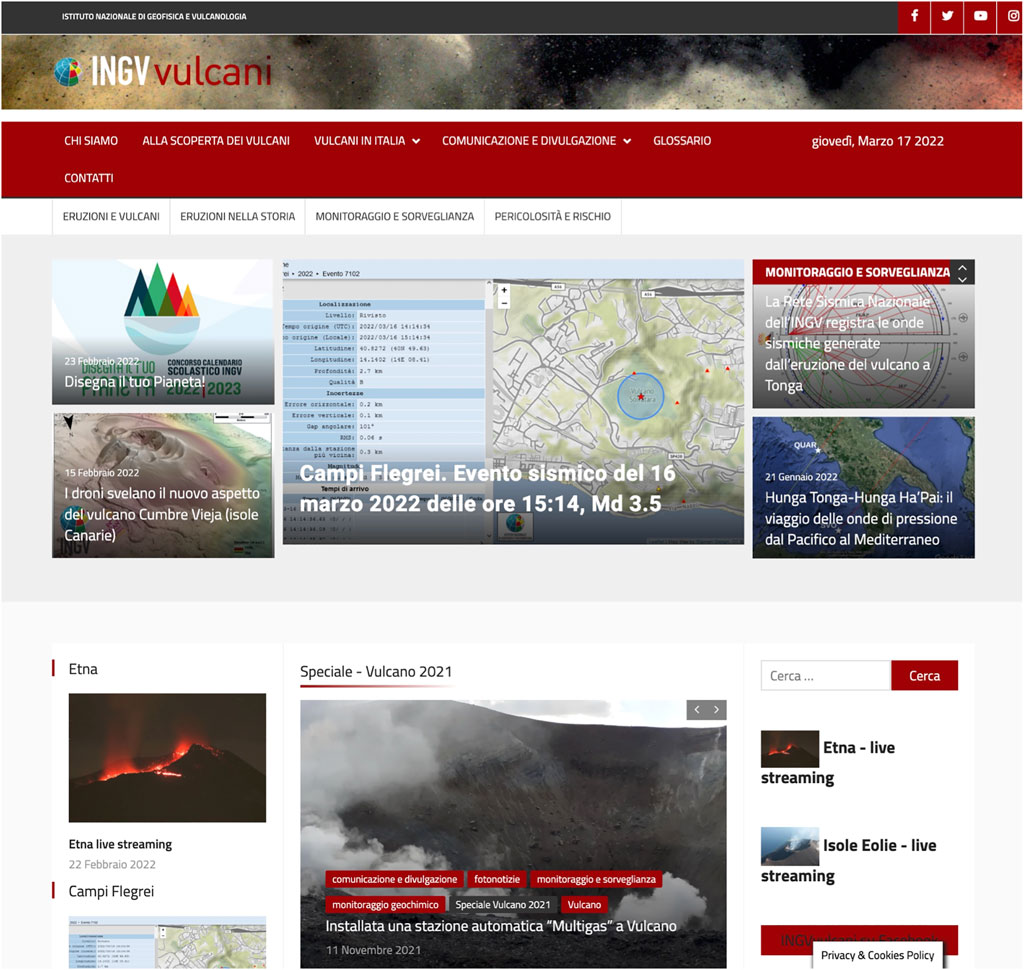
FIGURE 1. The renovated layout of the INGVvulcani blog, as it appeared on 17 March 2022. On that day, the highlights featured the article on the Md 3.5 Campi Flegrei seismic event (top, centre) and the special section on the unrest at Vulcano (bottom, centre). Articles about volcano monitoring and surveillance are available on the right, while the photo-news appear on the left. Further contents are available by scrolling the page. Static pages are accessible through the upper menu (red background), while published articles are listed in the category menu (white background).
The adopted information architecture provides for the categorization of contents and the creation of hierarchies. Articles are divided into thematic categories: “Eruptions and volcanoes,” with specific subsections on Italian and abroad volcanoes; “Eruptions in history”; “Volcanic monitoring and surveillance”; “Hazard and risk.” This classification allows users to quickly identify and search articles by topics. The new graphic version of the blog also highlights articles with specific characteristics, such as, for example, the photo-news, featuring a short text always accompanied by photographs, useful to quickly disseminate updated information.
A secondary menu organizes the contents according to their editorial characteristics, for example, photo news, resources (which include links to videos, documents and games), bulletins and infographics, as well as FAQs and a glossary, and a contact form, through which users send their requests.
Since its opening, in July 2018–February 2022 the blog has had a total of 12,51,202 views and 6,61,748 visitors. In detail, the trend of the views on a monthly basis partly depends on the number of articles published, but above all it reflects the occurrence of volcanic events in Italy or significant volcanic phenomena in Italian volcanoes, for which both updates and in-depth articles have been published (Figure 2A).
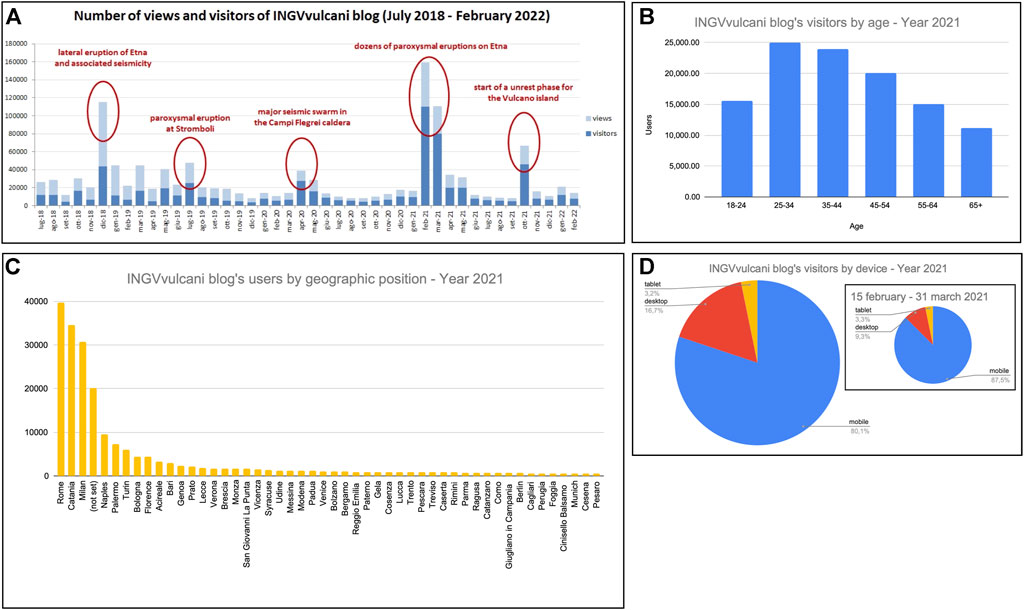
FIGURE 2. (A) INGVvulcani blog’s monthly views and visitors, since 2018. Attendance abruptly increases during volcanic crises, especially those involving Etna. (B) Age distribution of blog visitors in 2021. Plotted data refer to 44.2% of visitors (Google Analytics age data are available only for a subset of users). (C) Geographic locations of INGVvulcani blog visitors, in 2021. (D) Devices used to access the INGVvulcani blog in 2021. The same is also shown for the period 15 February–31 March 2021, characterized by intense paroxysmal activity on Etna (inset).
Over the years, peaks in the number of views occurred in conjunction with particular events—mostly volcanic emergencies—that attracted public attention, such as: 1) the lateral eruption that occurred at Etna in December 2018 and associated with seismic activity on the southeastern flank of the volcano; 2) the paroxysmal eruption of Stromboli in July 2019, further discussed below; 3) the major seismic swarm occurred in the Campi Flegrei caldera in April 2020, and 4) the series of paroxysmal eruptions that took place at Etna in February-March 2021. Finally, another peak of visualisations occurred in October 2021, with the onset of an unrest phase on the island of Vulcano, as further discussed in the section on case studies.
The most read articles relate to volcanic activity and monitoring of Italian volcanoes, in particular Stromboli and Etna. An increased visitors’ interest in blog articles was also recorded in conjunction with mild eruptive activities, for which no specific information was published. This suggests how much volcanic phenomena always trigger people’s curiosity. We could also verify a great attention toward educational contents (available as “Resources”) and general volcanological topics that can be used by teachers in their lesson plans.
The considerable increase in visitors and views during volcanic emergencies indicates that the INGVvulcani blog is an authoritative reference channel of information for citizens.
An analysis of the blog audience for the year 2021 shows:
- the age group with the highest number of users is between 25 and 45, with a slight predominance of male visitors (53%) (Figure 2B).
- most visitors are from Sicily, i.e., from the Italian region where the most active volcanoes are located (Figure 2C)
- during this year, about 80% of the users accessed the blog with a mobile device, such as smartphones or tablets. Mobiles are used even more (about 90%) to acquire information during paroxysms (Figure 2D). This suggests the usefulness of producing quick and concise information to be shared and disseminated easily.
Every time a new article is published on the INGVvulcani blog, the news is shared with posts on social media (Facebook, Twitter, and Instagram). Due to limited human resources, we have chosen not to open the blog to comments. However, visitors can contact the group via email, while we address direct questions or comments that are posted on social media (particularly on Facebook).
2.2 The INGVvulcani Social Media
The INGVvulcani presence on social media began with the creation, in July 2018, of a Facebook page (https://www.facebook.com/ingvvulcani), followed by the opening of a YouTube channel (https://www.youtube.com/c/INGVvulcani). The following year, we added Twitter (https://twitter.com/INGVvulcani) and Instagram (https://www.instagram.com/ingvvulcani) accounts. At the time of writing (March 2022) the Facebook page counted 36,678 followers. They are mostly from Italy (85%), from Sicily in particular (25%), and women are slightly more represented (52.1%) than men, across an age range from 25 to 64 years old (Figure 3A). In March 2022, the Instagram account had 6,665 followers. In this case, men outnumber women, and the average age is slightly younger (Figure 3B). The public is again mostly Italian (69.7%), but with a slightly larger fraction of foreigners (mostly from France and Germany). Over the same period of time, Twitter has reached a higher number of followers (9,478) and the tweets gain an average number of visualisations of the order of 1,00,000 per month, with an average interaction rate that in the last 6 months ranged from 2.6 to 5.8%.
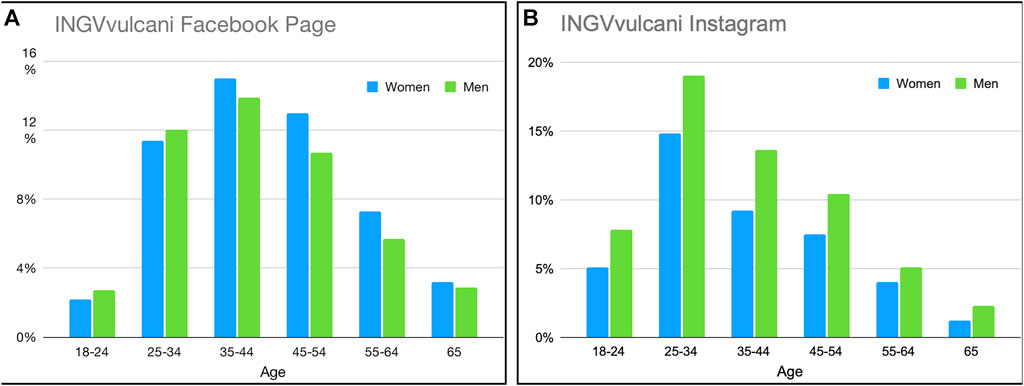
FIGURE 3. Age distribution, per gender, of the followers of the INGVvulcani facebook page (A) and Instagram account (B).
All social media are used to inform the public when new contents are published on our blog, or on the INGVvulcani YouTube channel; we also share the surveillance bulletins that are periodically issued by INGV volcano observatories to describe the state of activity of Italian volcanoes and those occasionally released because of any ongoing volcanic phenomena. Posts are also published to inform about remarkable eruptions in other countries or to celebrate and remember famous eruptions of the past. We advertise events or activities that may be of interest to the general public and describe scientific results or technological advancement in the volcanology field. When possible, we share images and descriptions of researchers at work, both in the field and in their laboratories, to provide a glimpse at the multifaceted activities carried out at INGV. Figure 4 shows the Facebook page performance for the year 2021. The most successful posts are those published to describe Etna eruptions.
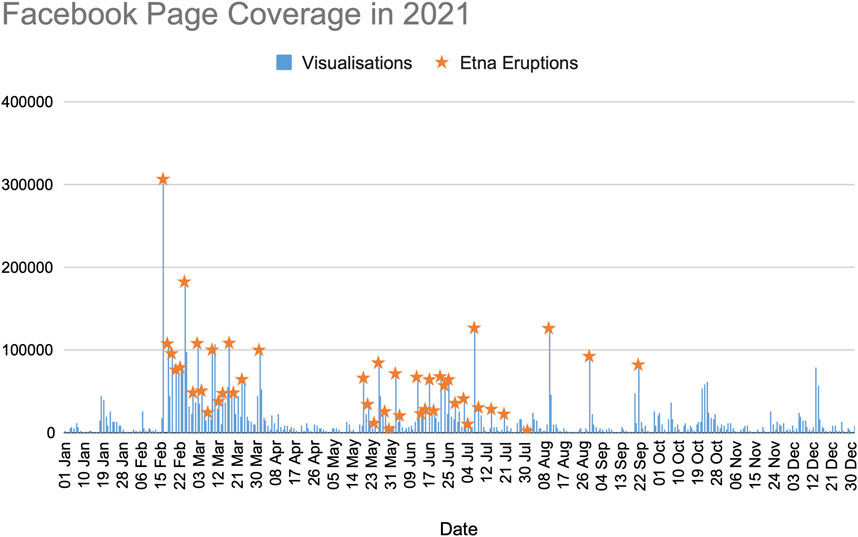
FIGURE 4. Visualizations achieved by the Facebook page INGVvulcani in 2021. Stars indicate the timing of Etna eruptive activity.
Only on a few occasions, we could organise a live streaming of researchers in the field on our Facebook page. As expected, videos are highly appreciated, especially those with live footage of erupting volcanoes. Rather than publishing them directly on Facebook, Instagram, or Twitter, we prefer to collect them on the YouTube channel and then share the link across the various platforms, to ensure easy access at all times. As already shown for the blog case, the number of visitors for all social channels increases during periods of intense volcanic activity. Post and live videos describing ongoing activity may easily reach coverage of the order of hundreds of thousands each and are those that prompt greater interactions.
The YouTube channel has 4,590 subscribers and collects more than 170 videos, organised into 19 playlists. Videos feature footage of volcanic activities or researchers working in the field in various locations. Some of the videos were shot from drones, or show images from satellites or from thermal cameras. Other videos were produced for outreach purposes (such as those produced by the international VolFilm project, sponsored by IAVCEI https://www.iavceivolcano.org/new-public-information-films-on-volcanic-hazards-and-their-impact/) and focus on different volcanic phenomena, or propose tutorials for simple scientific experiments.
3 The Calm Before the Storm
The INGVvulcani activities began in the summer of 2018 and could take advantage of a relatively quiet period, during which we could disseminate general information about volcanoes and their activities and about volcanological research and surveillance. Since then, during quiet times, we publish blog articles that deal with general subjects like: 1) the ongoing volcanic activity around the world (Supplementary Table S1); 2) famous and well-studied eruptions (Supplementary Table S2); 3) various volcanological processes and methods that are used to study and monitor volcanoes (Supplementary Table S3). This kind of general information often targets dormant volcanoes to highlight their past behaviour or describe how dormant volcanoes may transit from quiescence to unrest to eruption. During quiet time is also more likely to address complex issues, like the unpredictability of certain volcanic phenomena, or the uncertainty in science. To engage different kinds of public, a good effort was also made to highlight the connections between volcanic phenomena, art and culture (Supplementary Table S4). Figure 5 presents a timeline of these different kinds of contributions. These different types of content roughly correspond to the categories mentioned in Section 2.1. Both our blog and our social media are also used to describe forthcoming public events (such as exhibits or science festivals), or to celebrate anniversaries or significant dates (such as the Earth’s Day, or the International Day of Girls and Women in Science, or the European Researchers’ Night). Posts and articles may also promote and share new outreach materials produced by INGV, such as booklets, infographics, or videos, as they become available.
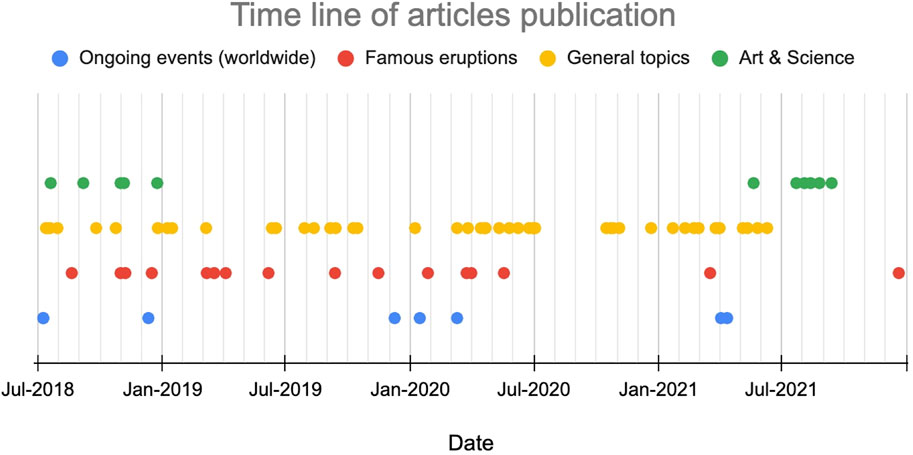
FIGURE 5. Timeline of blog publication for general articles during quiet times. Contributions related to ongoing activities at Italian volcanoes are not included here.
Even during quiescence times, this flow of general information alternates with periodic updates on the activity of Italian volcanoes. Both Etna and Stromboli produce frequent summit eruptions that bear little consequences on the surrounding inhabited areas, but gather a great attention and a widespread demand for information even when they do not pose particular threats. To meet this demand, we try to provide timely updates, such as: 1) news about the onset of activity at one of our volcanoes; 2) publication of surveillance bulletins issued by the INGV observatories; 3) drafting of specific articles that provide details and contextualise the ongoing phenomena. Sometimes, short information articles or posts are also written to debunk fake news or rumours that circulate online. Examples range from the presumed increment of volcanic activity worldwide to the supposed opening of a new crater in the Campi Flegrei caldera (Supplementary Table S3) or, more recently, the concerns about a volcanic origin of the anomalous lake water colour, in the same caldera.
Through the years, and especially during times of volcanic quiescence, the INGVvulcani working group also populated the YouTube channel, uploading outreach videos on specific volcanic processes, footage describing activities in the field, laboratory experiments or results from numerical simulations. Each video is accompanied by a short description and is promoted through posts on social media and sometimes also through blog articles (Figure 6).
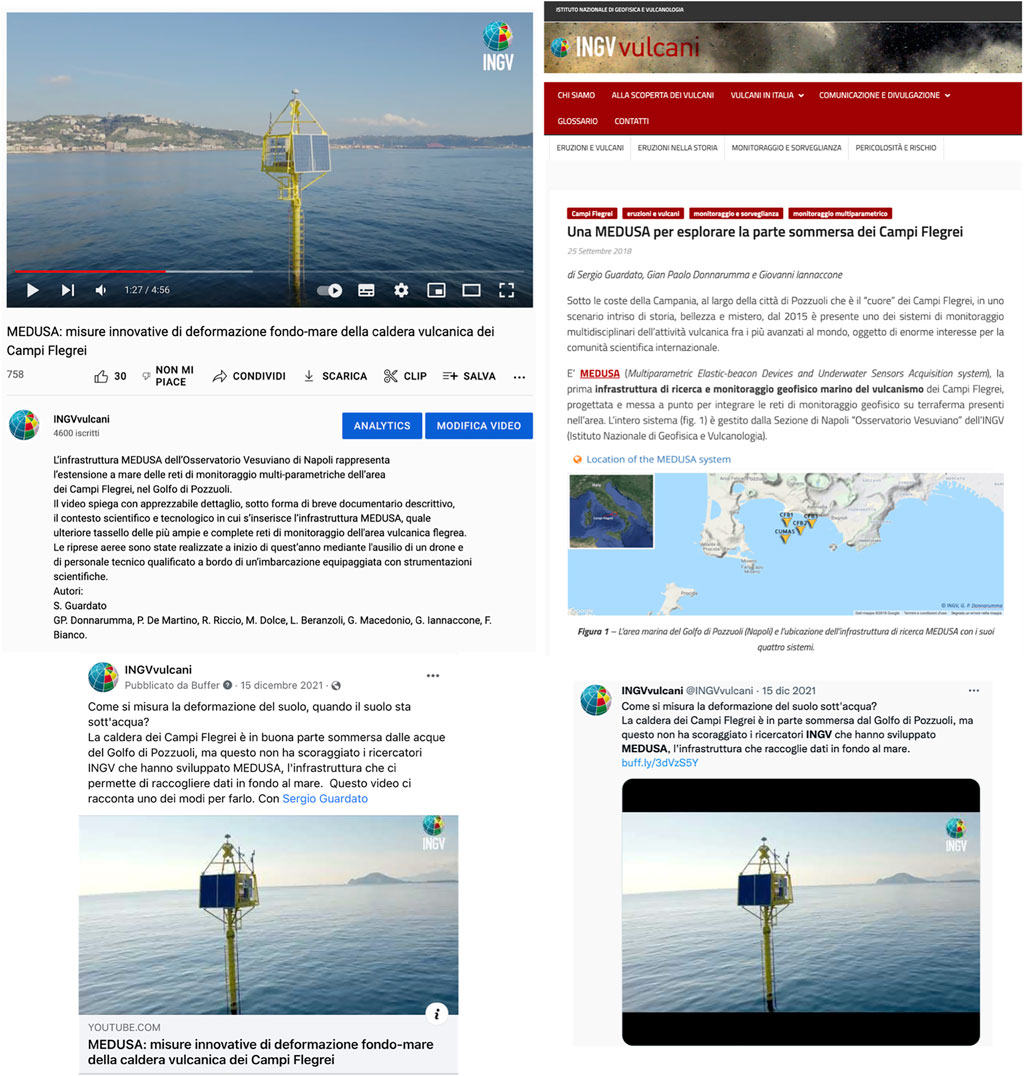
FIGURE 6. An example of coordinated dissemination about the subaqueous monitoring system MEDUSA, featuring a dedicated video on YouTube (upper left), a blog article (upper right), and the related posts on Facebook (lower left) and Twitter (lower right).
We tried to maintain a rather constant rate of general content publications and a timely release of news. Even if this is not always the case, we have chosen to give preference to robustness over speed of publication, so as to always provide high-quality information.
Unsurprisingly, articles and posts that do not refer to ongoing activity are usually met with lower interest than those that deal with erupting volcanoes (Figures 2, 4). Nevertheless, they contribute to build a continuous flow of information and establish a connection with the public. Outreach contents that are disseminated during quiet times remain available online and can be easily referred to when eruptive activity resumes and the public attention increases. The availability of general volcanological contents may become very handy in the frantic times of volcanic emergency.
4 Online Description of Volcanic Crises
INGVvulcani faced different kinds of volcanic emergencies: the first one occurred in 2019 on the Island of Stromboli, with two paroxysmal explosions (Andronico et al., 2021) during the summer. The communication of these events is described in some detail below. Another long-lasting period of intense volcanic activity occurred in 2021-2022, when Etna produced a remarkable series of 54 paroxysmal episodes, featuring impressive lava fountains and widespread ash fallout, often accompanied by loud roaring and infrasound signals. These eruptive phases were witnessed by millions of people in the surrounding areas and attracted great attention toward any kind of information we provided online about the ongoing activity. Our posts and article prompted a quick and warm response, with followers mostly expressing gratitude for our monitoring efforts and sharing their own images and descriptions of the eruptive activity and its products. A more detailed account of the communication effort carried out during Etna’s recent volcanic crises will be given in a separate publication.
A different kind of attention surrounds episodes of volcanic unrest at otherwise quiescent volcanoes, such as the Campi Flegrei caldera. The area is populated by more than half a million people and represents one of the highest risk volcanic systems in the world. Since the mid-twentieth century, it has been subjected to various cycles of subsidence and ground uplift (bradyseism), associated with a low seismicity (Del Gaudio et al., 2010). Since 2005, the Campi Flegrei caldera has been going through a new uplift phase, which displays an accelerating trend since 2012, when the alert level was raised from green to yellow. The uplift is accompanied by frequent low-energy shallow seismicity, by changes of the chemical composition of the main fumaroles, together with an increased flux of carbon dioxide (CO2), which is discharged through fumaroles and diffusely through the ground of the caldera (Caliro et al., 2014; Chiodini et al., 2015; Chiodini et al., 2016). This activity has been going on for over a decade, and generates concerns especially when shallow earthquakes are perceived by residents. INGVvulcani grants information when relevant seismic events and seismic swarms occur. We also work to provide a complete picture of this complex volcanic system and of the surveillance networks that are in place. Through time, we published thorough in-depth articles describing the eruptive history, mineralogy and magmatic processes, as well as monitoring and its results. Weekly and monthly surveillance bulletins are also shared through INGVvulcani social media as soon as they are released by the Osservatorio Vesuviano.
Another episode of volcanic unrest occurred in 2021, on the Vulcano Island. A remarkable increase in gas emissions was observed not only at the crater fumaroles, but also through the soils, right within the inhabited area, generating concerns. In the following, we focus our attention to the volcanic crises in Stromboli (in 2019) and Vulcano (in 2021), describing the communication strategy adopted in each case. The two emergencies took place in a similar setting (small, touristic island) but were very different in terms of volcanic phenomena and impact.
4.1 The 2019 Paroxysmal Eruptions at Stromboli
The so-called “Lighthouse of the Mediterranean Sea” usually features a persistent Strombolian activity at its summit craters. Here, multiple vents produce “ordinary” explosions every few tens of minutes amid a continuous degassing. Ejecta usually reach heights of several tens of metres and fall within the crater area (Rosi et al., 2013; Calvari et al., 2014). On occasions, the energy of the explosions increases, and the volcano generates the so-called “major explosions” (Barberi et al., 1993; Polacci et al., 2009; Calvari et al., 2014): in these cases, ejecta may reach heights of a few hundred metres and may form a volcanic plume that rises up to 1 km above the vents. The volcano is also capable of generating “paroxysmal” eruptions, that usually involve all active vents at the same time and throw lava blocks and meter-sized bombs to as far as the coast and the inhabited areas, up to 2 km from the vents (Bertagnini et al., 2011; Calvari et al., 2011; Bevilacqua et al., 2020; Métrich et al., 2021). During paroxysms, the eruptive column of gas and ashes may reach several kilometres above the craters, and its development is commonly accompanied by loud detonations. Pressure waves may break window panes in the villages at the volcano’s foot. During the last decades, paroxysms occur on average every 4 years, although higher frequencies have been observed in the past, and have a strong tendency to occur in clusters (as major explosions).
The summer season in 2019 began with a “major explosion” that took place in the middle of the night, on 25 June. Information about this event was published on the INGVvulcani Facebook page the day after (26 June), both in Italian and English considering the presence of tourists on the island. The post included a video created with photos shot by the INGV thermal camera located near the volcano summit. By the end of June, the video was viewed more than 24,000 times. Only a few days later, on the afternoon of 3 July 2019, the volcano generated a paroxysmal eruption (Plank et al., 2019; Andronico et al., 2021; Giordano and De Astis, 2021; Viccaro et al., 2021). This event was initiated by a series of explosions associated with lava emission and it culminated shortly after with major blasts involving all active summit vents. The eruptive column reached an estimated height of 4 km. Its partial collapse, associated with the products of lateral blasts, caused two pyroclastic density currents that propagated along the deserted Sciara del Fuoco, past the seashore and expanded over the water for a few hundred meters. Fallout of bombs and lapilli set the vegetation on fire in numerous locations, while ash fallout covered both villages on the island. At the end of the paroxysmal phase, an intense Strombolian activity resumed, while lava continued to flow down the Sciara, forming several branches. During the paroxysm, one person died near the village of Ginostra, probably because of inhalation of ashes and smoke from the brush fires. Access to the summit area was forbidden to visitors.
After approximately 2 months of lively Strombolian activity and sporadic episodes of lava emission, another paroxysmal eruption occurred on 28 August 2019, around noon. Seismic signals allowed us to identify three major explosions that altered the morphology of the crater terrace. As in the case of the July event, the paroxysm featured a lateral blast and generated a 4-km-high eruptive column, with tephra fallout over the entire island. Another pyroclastic current formed and propagated down the Sciara del Fuoco and over the sea surface, for a distance of a few hundreds of meters. After the main explosions, a lava flow was emitted on the Sciara del Fuoco, and it reached the shoreline in the evening of the same day. The succession of events and signals recorded by monitoring systems during each paroxysm is reported in Giudicepietro et al. (2020).
In 2019, the INGV staff dedicated to communication and outreach was not yet organised in shifts available on call. Nevertheless, the first information about the first paroxysmal event was available online about half an hour after the eruption. To ensure timely information and avoid ambiguity, we decided to publish the rather technical official communication that was sent by the INGV surveillance room in Catania to the Dipartimento della Protezione Civile. The post was illustrated by the last images taken by the summit infrared thermal camera before being hit by the blast (Figure 7), and it quickly reached tens of thousands of visualisations, despite the Facebook outage experienced on that day for several hours (https://www.computerweekly.com/news/252466258/Facebook-Instagram-and-WhatsApp-outage-resolved-but-questions-remain-over-what-caused-it). Thanks to the presence of personnel on the ground, who were on duty in the INGV visitor centres during the summer months, we could also quickly retrieve and publish a short video of the eruptive column rising above the volcano (Figure 7). Videos from INGV thermal cameras were also made available on the YouTube channel.
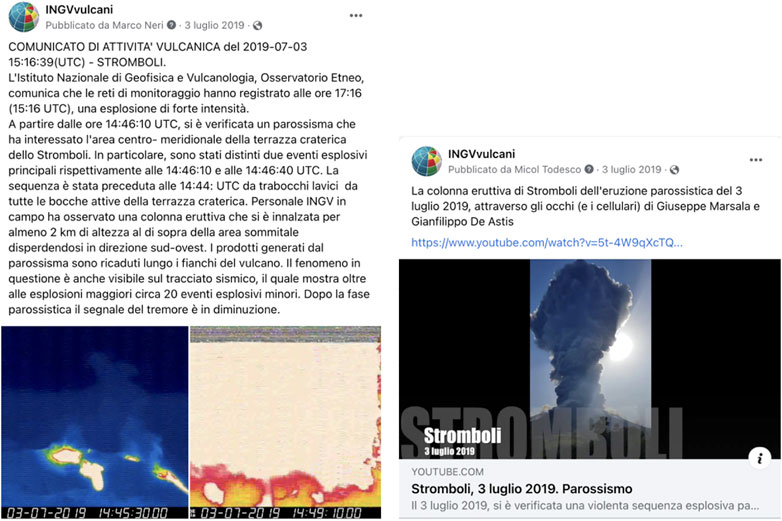
FIGURE 7. Facebook posts informing about the 3 July 2019 paroxysmal event at Stromboli (left), and linking a video of the event posted on the INGVvulcani YouTube channel (right).
Afterwards, the group worked to produce more exhaustive descriptions of the events that were published as blog articles in the following days. During the summer of 2019, information regarding the island and its volcanic activity was provided regularly, together with posts describing the activity of researchers in the field to restore damaged equipment or to gain information about the products emplaced. Figure 8 shows the timeline of the contents related to Stromboli that were published on INGVvulcani social media during the summer of 2019.
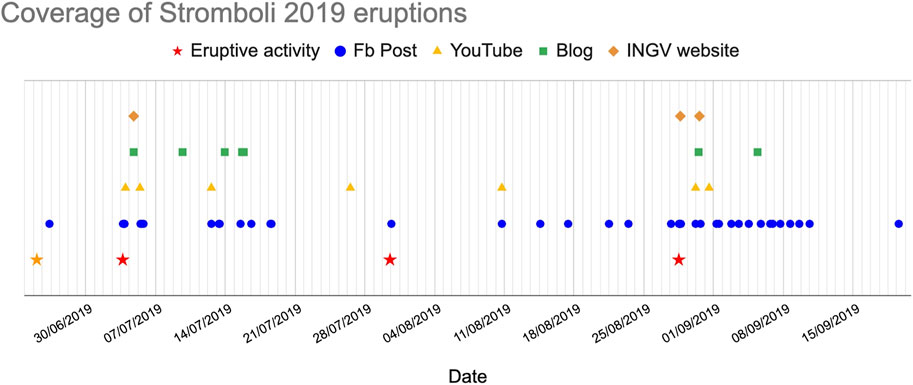
FIGURE 8. Time line of Facebook posts, YouTube videos, and blog articles informing about the paroxysmal events occurred in Stromboli during the summer of 2019. Eruptive events are marked as stars and include the 25 June “major” explosion (in yellow), the two paroxysmal eruptions on 3 July and 28 August (in red), and the lava flow on 30 July (also in red).
News about the second paroxysm was given with four Facebook posts published during the same day of the eruption, first with details taken from the official communication, then with the publication of the seismic traces recorded during the event, and finally with by pictures of the event and videos from the INGV monitoring cameras (Figure 9).
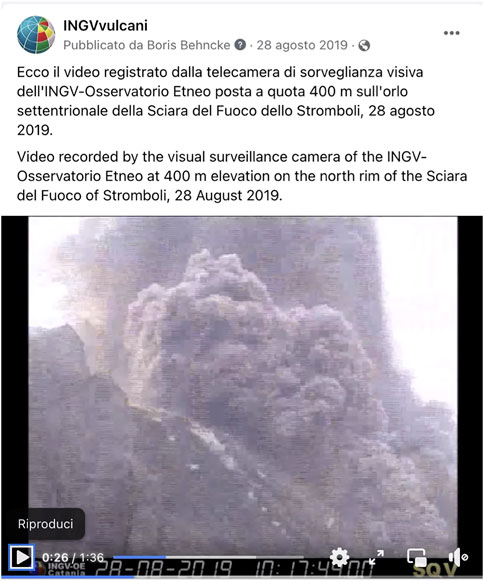
FIGURE 9. Facebook post describing the second paroxysm (28 August 2019) with footage from the surveillance camera located on the volcano slope that survived the first event.
All the posts published during the summer 2019 gained much attention, easily reaching hundreds of thousands of visualisations (Figure 10). Posts on the Facebook page were variably commented and shared. On 3 July, the first post with the official communication of the eruption was shared 100 times, while the most discussed post (18 comments) was linked to a video of the eruption (shared 82 times). The conversation about this post mostly focused on the amazing power of volcanic eruptions but it also regarded the lack of evident precursory signs of that eruption and the occurrence of a casualty. Some of the comments shared photos and videos of the eruption or links to additional footage. The second paroxysm received more attention, in terms of visualisations. The first information about the eruption was shared 458 times and received 17 comments, but the video from the monitoring camera was shared 1,086 times. In this case, comments (47) mostly express feelings of surprise, fear or wonder, or they were used to tag along other people or to share other images. The different coverage reached by the information on the two eruptions is likely associated with the Facebook accessibility problems on the third of July. August is also a popular month for the summer break, and it is possible that a larger audience was available to check the news on Facebook than at the beginning of July.
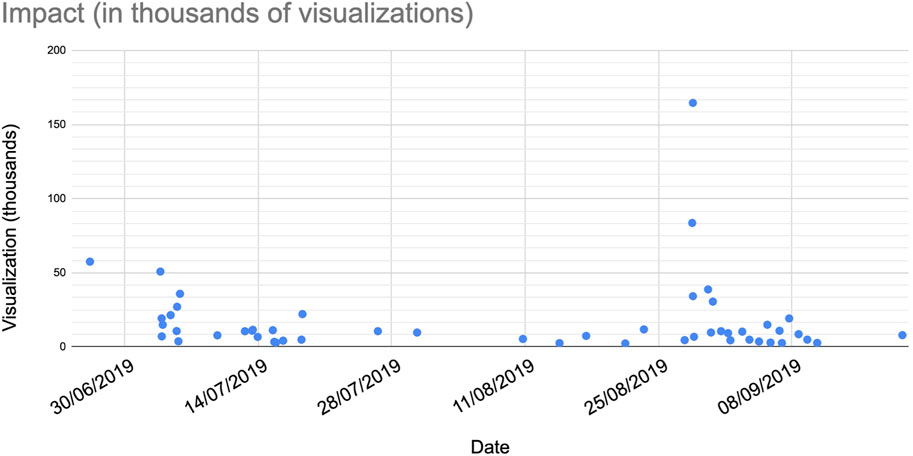
FIGURE 10. Number of daily visualisations of INGV contents about Stromboli 2019 eruptions published from June to October 2019 on Facebook, YouTube, and on the INGVvulcani blog.
4.2 The 2021 Volcanic Unrest at Vulcano
The Island of Vulcano belongs to the Aeolian Archipelago, like Stromboli, and is another Italian active volcano that recently experienced a phase of volcanic unrest, still going on at the time of writing. The active tuff cone of La Fossa has been quiescent since the last eruption that took place in 1888–1890 and closed a few centuries of frequent and short-lived eruptions. Thanks to the detailed description by Giuseppe Mercalli, the island lent its name to the eruptive style (Vulcanian explosions), featuring a viscous magma fragmented by moderate explosions into tephra of a large variety of sizes, ranging from ashes to the typical bread-crust bombs that could reach well beyond the base of the cone. Afterwards, the activity on the island has been associated with a vigorous hydrothermal circulation that feeds a widespread fumarolic field in the crater area and some fumaroles along the beach. Diffuse carbon dioxide emissions are identified at various locations on the island at the base of the cone. Through time, the island experienced periods of unrest, mainly featuring increases in both gas temperature and discharge rate and changes in chemical and isotopic gas composition, sometimes accompanied by ground deformation and seismicity (Selva et al., 2020 and references therein). Temperatures in excess of 600°C were recorded in 1924, and then again at the beginning of 1990s (690°C, in 1993). The unrest period from 1987 to 1993 featured large changes in gas composition, which highlighted an increasing contribution of magmatic components, and were accompanied by greater gas output from crater fumaroles, ground deformation and seismicity. Then, gas temperature declined but the degassing area increased again (to a lesser extent) in 2004-2005 and in 2009.
Since the late summer of 2021, the INGV monitoring systems suggested the beginning of a new unrest phase, characterised by similar anomalies as in the previous unrests. Gas temperature reached values in excess of 400°C, degassing visibly increased both along the crater rim and at the base of the cone and gas composition showed a sudden increment of the magmatic components. Ground deformation affected the active cone, and shallow seismicity was recorded featuring for the first time VLP events associated with fluid circulation. On the first of October 2021, the intensity of these anomalies guided the decision of the Dipartimento della Protezione Civile to raise the alert level for national emergency from green to yellow. In the following weeks, indoor measurements revealed dangerous gas concentrations at selected sites and prompted a temporary overnight ban that was issued by the Mayor in November. The ban was partially lifted in December 2021.
During the spring of 2021, INGV formally established a 24/7 on-duty service for staff dedicated to communication about volcanoes and volcanic activity. The availability of dedicated staff greatly contributed to the efficacy of our communication. The news about the volcanic unrest was published by INGVvulcani on the same day the alert level was shifted to yellow. A brief text, entitled “What is going on in Vulcano?” was published on the blog, as a photo-news, and then shared through the three social media (Facebook, Instagram, and Twitter, Figure 11). The Facebook post quickly reached more than 26,000 views. Within a few days, we published additional information about the eruptive history of Vulcano, mentioning both its previous eruptions and its more recent unrest episodes. Since 13 October, the INGV Osservatorio Etneo in Catania began to release weekly surveillance bulletins on the state of the volcano that were consistently shared online. As for the case of Stromboli, we also posted videos and photos from INGV staff working on the island to collect gas samples, install new instruments and ensure the functioning of monitoring networks. Images were often accompanied by short blog articles, providing insights on both the ongoing process and the monitoring efforts. These pieces focused on: 1) the observed anomalies; 2) previous eruptive activities and unrest at Vulcano; 3) monitoring of volcanic gases; 4) gas temperature and its changes; 5) the installation of a multi-gas station, and 6) the ongoing improvement and extension of monitoring networks prompted by the alert level shift. We uploaded eight videos on the YouTube channel, some of which were taken from drones, showing the vigorous degassing activity taking place along the crater rim. Given the relevance of the gas emission due to the ongoing crisis, we also proposed on our social media the VOLFilm videos on gas hazards that are available in Italian on the INGVvulcani YouTube channel. Adding to the video, the group also coordinated an effort to produce an infographic describing the gas hazard on the island. The infographic was designed by the INGV graphic lab in Rome, with the substantial contribution of INGV staff involved in monitoring diffuse degassing on the island. The infographic was presented to the public during the civil protection exercise organised at the beginning of April 2022. The Facebook post reached more than 14,000 visualisations. By the end of 2021, all contents published about Vulcano and its unrest totalled approximately 5,00,000 views. The interest gradually declined in the following months, together with the progressive diminution in some of the observed anomalies (updated April 2022).
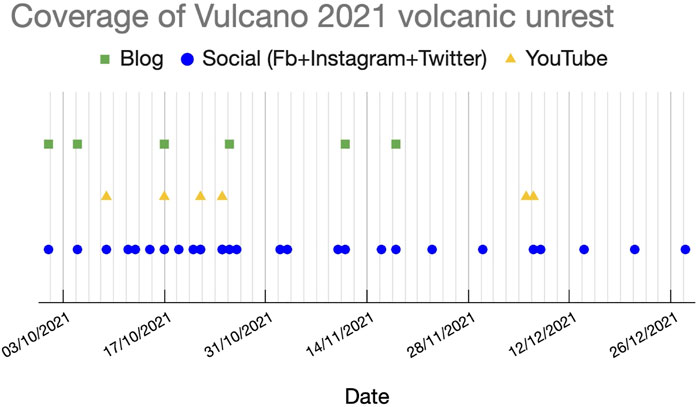
FIGURE 11. Time line of Facebook posts, YouTube videos, and blog articles informing about the 2021 Vulcano unrest.
5 Discussion and Final Remarks
The INGV Volcanoes Department (Dipartimento Vulcani) has been present online since 2018 with a blog, a Facebook page, a YouTube channel, and later on with Instagram and Twitter accounts, all branded INGVvulcani. Since then, we have been providing information about volcanoes and volcanic activity in Italy and abroad, during both volcanic crises and periods of volcanic rest. We gradually increased the amount of outreach content that we share, reaching out to a wider audience, year after year (Table 2). During these 5 years, we gained some insights about social communication, that we summarize below:
• A wide community gathered rather quickly around the INGVvulcani channels. As we established a continuous flux of correct information, we gained the position of reliable provider of scientific information about volcanic activities in Italy. People who are either curious or worried about volcanoes soon began to consider INGVvulcani a trusted reference point to retrieve information on the subject. The comments that we have been receiving on the Facebook page are, for the vast majority, appreciative of the contents we share. The quick growth of followers confirms a widespread interest toward accurate scientific information (Sennert et al., 2018) shared in Italian and with accessible wording.
• People’s interest and involvement are not easily predictable. We assumed that the publication of images and videos was the best way to attract visitors. During Stromboli’s volcanic crisis in 2019, the post sharing the official information about the first explosion was published with an image from the INGV thermal camera that simply showed the position of the vents, with no eruption, and it received over 50,000 visualisations; the blog article published the day after was accompanied by a beautiful picture of the eruptive column towering over the island, and gathered over 21,000 visualisations. The following day we posted a video shot during a surveillance flight over the active craters, which collected less than 4,000 views. At the end of the summer, a video from the INGV surveillance camera that captured the second paroxysm obtained more than 1,60,000 visualisations, while the official information about the second eruption totalled more than 83,000 views. This brief experience suggests that great footage does not necessarily grant greater visibility. On the other hand, official bulletins, which we deemed rather unappealing with their technical jargon, were received and shared much more than we expected. The success of a piece depends on the actual demand for information. In the aftermath of both of Stromboli’s paroxysms, thousands of photos of the eruptions, taken from every possible perspective, were readily available online. The addition of a few more images did not add much to what was already available to the public. On the contrary, the factual information from volcanic surveillance was rather unique, and it met the interest of many, even though communiqués and bulletins are not written for a general public.
• Numbers (visualisations, followers, shares) provide a partial picture. The size of the community that is interested or is potentially affected by volcanic activity also influences the outcome of our communication efforts. Similar Facebook posts describing harmless Strombolian activity at summit craters may obtain tens of thousands of visualisations when they refer to Stromboli, but easily exceed hundreds of thousands of views in the case of Etna. This confirms that simple indicators, like the number of followers, provide a rather simplified description of the public interest and of the relevance of published contents. Different topics and volcanic phenomena are also met with different levels of attention or anxiety, and this is another element that affects the coverage of posts and articles. The blog piece about the unrest at Vulcano reached almost 40,000 views, while an article published a week earlier to present new infographics on INGV operation rooms was only noticed by 400 people. Volcanic crises capture the public’s attention and increase the search for information online. This occurs not only in case of volcanic eruptions, but also in case of volcanic unrest, when the uncertainty about the possible outcome may cause justified concern among the exposed community.
• During volcanic crises, the dissemination of timely, concise, accurate and consistent information is an essential goal of our social channels. We addressed crises by providing updated news on the ongoing events and their evolution, as soon as sound data became available. We relied on official communiqués and bulletins. We chose to avoid any simplifications of the technical jargon as to prevent ambiguities and maintain a unique description of the events, for all stakeholders and the general public across all platforms and websites. At the same time, we made sure that our audience had access to an updated glossary that explained technical terms. We are not entirely satisfied by this approach, as we understand that technical jargon may represent a significant barrier. We plan to work and elaborate a simplified version of the official bulletins aimed at the general public. We publish information as soon as possible, but we favour accuracy over timeliness, as our main goal is to provide robust information based on verified data.
• Build on people’s attention. Contents published during eruptions or volcanic unrest were not limited to the description of ongoing phenomena. We worked to produce specific in-depth information that is needed to clarify the context within which the crisis occurred. The high level of interest associated with ongoing events facilitates the dissemination of contents. Insights articles aim at providing the necessary background that is needed to interpret the current events. We may describe the eruptive history of the volcano, or introduce a specific volcanic phenomenon and its typical evolution. Sometimes we compare ongoing activities with analogous events that occurred in the past at the same volcano or at different volcanoes, discussing their impact. This information complements the updates on the crisis evolution and in our intentions, it should provide a reference point and a scale to better size ongoing events and their possible outcome.
• Media-friendly contents are a great asset. Thanks to their newsworthiness, volcanic crises may easily reach headlines, and often are used as click-bait content. With time, we noticed that an increasing number of traditional and online newspapers and tabloids, both at regional and at national level, began to use our description of volcanic eruptions. Even click-bait websites started relying on our contents rather than forging unlikely reconstructions based on hearsay and non-official sources. Even though our channels are not always clearly mentioned as the original source of the content, we consider the widespread use of our outreach information as a sign of a successful approach, capable of providing correct scientific information where and when needed.
• A continuous presence and a regular flow of information are important and appreciated. Credibility and trust are built and reinforced during non-eruptive periods. Apparently met with less interest, the insight articles published during times of quiescence allows us to address a wide range of interesting topics that may become handy during crises. The periodic publication of bulletins is an eagerly awaited appointment, commonly re-posted by many followers, Meanwhile, a steady flux of contents contributes to building a stronger relation with our public, consolidating our online presence as a trusted institution (Sennert et al., 2018). Dissemination articles that do not directly refer to ongoing eruptions allow us to share basic volcanological information and clarify the way in which scientific knowledge is built and how it is continuously refined and tested against new data (Todesco, 2017). Widespread understanding of the scientific process is needed to allow science to play its unique role in society, by providing citizens with information that is justified beyond individual understanding, being founded on reliable, systematic segments of scientific knowledge.
There are ample margins of improvement. We use different social media in a similar way, sharing the same contents over different platforms instead of creating channel-specific materials. We still make very little use of live streaming and our actual interaction with the public is limited to answering some of the comments and questions that we receive. We plan to improve all these aspects in the future, and we are working to reach a wider audience near dormant volcanoes, where the public attention is not catalysed by eruptive activity. We will seek in the future a greater interaction with other volcanological institutions, in Italy and abroad, by sharing their contents and by publishing more outreach materials suited for an international audience. We are also aware that the number of visualisations on social media is a very weak indicator of public engagement. The efficacy of any communication strategy should be tested with ad hoc multidisciplinary studies involving representative samples of the targeted population. This is particularly true for the communication that regards potentially hazardous phenomena, such as volcanic activity, where scientists are asked to share useful and usable information to mitigate volcanic risk. This is not an easy task.
Communication on social media is driven by a fast, continuous flow of news that fragments the audience into unconnected spheres of alternative information, often conditioned by algorithms run by social media networks. In this context, misinformation and disinformation thrive and easily mingle with scientific contents. As the public attention toward natural phenomena increases, geoscientists are expected to take a stand and actively participate in a public conversation that demands conciseness, speed, clarity and certain answers even where uncertainty dominates. We are rarely trained to sustain such a conversation. We need to bridge the gap between scientists and local communities, possibly through the development of a common language. The choice of contents to be shared should be better tailored on each volcanic area, based on the specific volcanic hazards, but also accounting for the cognitive needs, the awareness, the psychological and social features that characterize each community. This is an ambitious goal that requires the adoption of more sophisticated analytical tools than those offered by social platforms and a long-term collaboration with social scientists, providing the expertise needed to approach the issue.
We are still learning and, with time, we hope that more and more researchers will become aware of the importance of good communication and will join our efforts, making our online community stronger and more effective in sharing scientific knowledge.
Data Availability Statement
The raw data supporting the conclusion of this article will be made available by the authors, without undue reservation.
Author Contributions
All authors actively participated in the INGVvulcani communication effort and contributed to conceive the article. MT collected and elaborated the data on social media coverage and suggested the article structure, writing various sections. MDL and EB gathered data and wrote the sections dedicated to the blog and to the ongoing unrest at Campi Flegrei. All authors worked on the written text, improving the language and adding missing information and references.
Funding
The activities of INGVvulcani are carried out by INGV researchers as a part of their institutional duties. The study has partially benefited from the financial contribution of the Italian Presidenza del Consiglio dei ministri, Dipartimento della Protezione Civile. The publication does not necessarily reflect the position and policies of the Italian Presidenza del Consiglio dei ministri, Dipartimento della Protezione Civile. The publication of the present article was supported by INGV, Sezione di Bologna.
Conflict of Interest
The authors declare that the research was conducted in the absence of any commercial or financial relationships that could be construed as a potential conflict of interest.
Publisher’s Note
All claims expressed in this article are solely those of the authors and do not necessarily represent those of their affiliated organizations, or those of the publisher, the editors and the reviewers. Any product that may be evaluated in this article, or claim that may be made by its manufacturer, is not guaranteed or endorsed by the publisher.
Acknowledgments
We wish to thank all the many colleagues who support the INGVvulcani activities and the two reviewers, whose comments helped us to improve the manuscript.
Supplementary Material
The Supplementary Material for this article can be found online at: https://www.frontiersin.org/articles/10.3389/feart.2022.926155/full#supplementary-material
References
Andronico, D., Del Bello, E., D’Oriano, C., Landi, P., Pardini, F., Scarlato, P., et al. (2021). Uncovering the Eruptive Patterns of the 2019 Double Paroxysm Eruption Crisis of Stromboli Volcano. Nat. Commun. 12, 4213. doi:10.1038/s41467-021-24420-1
Barberi, F., Rosi, M., and Sodi, A. (1993). Volcanic Hazard Assessment at Stromboli Based on Review of Historical Data. Acta Vulcanol. 3, 173–187.
Bertagnini, A., Di Roberto, A., and Pompilio, M. (2011). Paroxysmal Activity at Stromboli: Lessons from the Past. Bull. Volcanol. 73, 1229–1243. doi:10.1007/s00445-011-0470-3
Bevilacqua, A., Bertagnini, A., Pompilio, M., Landi, P., Del Carlo, P., Di Roberto, A., et al. (2020). Major Explosions and Paroxysms at Stromboli (Italy): a New Historical Catalog and Temporal Models of Occurrence with Uncertainty Quantification. Sci. Rep. 10, 17357. doi:10.1038/s41598-020-74301-8
Caliro, S., Chiodini, G., and Paonita, A. (2014). Geochemical Evidences of Magma Dynamics at Campi Flegrei (Italy). Geochimica Cosmochimica Acta 132, 1–15. doi:10.1016/j.gca.2014.01.021
Calvari, S., Bonaccorso, A., Madonia, P., Neri, M., Liuzzo, M., Salerno, G. G., et al. (2014). Major Eruptive Style Changes Induced by Structural Modifications of a Shallow Conduit System: the 2007–2012 Stromboli Case. Bull. Volcanol. 76, 841. doi:10.1007/s00445-014-0841-7
Calvari, S., Spampinato, L., Bonaccorso, A., Oppenheimer, C., Rivalta, E., and Boschi, E. (2011). Lava Effusion - A Slow Fuse for Paroxysms at Stromboli Volcano? Earth Planet. Sci. Lett. 301, 317–323. doi:10.1016/j.epsl.2010.11.015
Chiodini, G., Paonita, A., Aiuppa, A., Costa, A., Caliro, S., De Martino, P., et al. (2016). Magmas Near the Critical Degassing Pressure Drive Volcanic Unrest towards a Critical State. Nat. Commun. 7, 13712. doi:10.1038/ncomms13712
Chiodini, G., Vandemeulebrouck, J., Caliro, S., D'Auria, L., De Martino, P., Mangiacapra, A., et al. (2015). Evidence of Thermal-Driven Processes Triggering the 2005-2014 Unrest at Campi Flegrei Caldera. Earth Planet. Sci. Lett. 414, 58–67. doi:10.1016/j.epsl.2015.01.012
Dallo, I., Stauffacher, M., and Marti, M. (2022). Actionable and Understandable? Evidence-Based Recommendations for the Design of (Multi-)hazard Warning Messages. Int. J. Disaster Risk Reduct. 74, 102917. doi:10.1016/J.IJDRR.2022.102917
De Lucia, M., Pappalardo, L., Neri, M., De Astis, G., Bagnato, E., and Todesco, M. (2021). “Volcanic Hazard in Italy: a Variegated Landscape,” in Consorseguros Revista Digital, Consorcio de Compensación de Seguros. Madrid: Consorcio de Compensacion de Seguros. NIPO: 094-20-094-2. Number 15, Autumn 2021. Available at: www.consorsegurosdigital.com.
Del Gaudio, C., Aquino, I., Ricciardi, G. P., Ricco, C., and Scandone, R. (2010). Unrest Episodes at Campi Flegrei: A Reconstruction of Vertical Ground Movements during 1905-2009. J. Volcanol. Geotherm. Res. 195 (1), 48–56. doi:10.1016/j.jvolgeores.2010.05.014
Dufty, N. (2015). The Use of Social Media in Countrywide Disaster Risk Reduction Public Awareness Strategies. Aust. J. Emerg. Manag. 30 (1), 12–16. Available at: https://knowledge.aidr.org.au/resources/ajem-jan-2015-the-use-of-social-media-in-countrywide-disaster-risk-reduction-public-awareness-strategies.
C. J. Fearnley, D. K. Bird, K. Haynes, W. J. McGuire, and G. Jolly (Editors) (2018b). “Observing the Volcano World, Volcano Crisis Communication,” Advances in Volcanology (Cham: Springer). doi:10.1007/978-3-319-44097-2
Fearnley, C., Winson, A. E. G., Pallister, J., and Tilling, R. (2018a). “Volcano Crisis Communication: Challenges and Solutions in the 21st Century,” in Observing the Volcano World. (Cham: Springer), 3–21. Advances in Volcanology. doi:10.1007/11157_2017_28
Giordano, G., and De Astis, G. (2021). The Summer 2019 Basaltic Vulcanian Eruptions (Paroxysms) of Stromboli. Bull. Volcanol. 83, 1. doi:10.1007/s00445-020-01423-2
Giudicepietro, F., López, C., Macedonio, G., Alparone, S., Bianco, F., Calvari, S., et al. (2020). Geophysical Precursors of the July-August 2019 Paroxysmal Eruptive Phase and Their Implications for Stromboli Volcano (Italy) Monitoring. Sci. Rep. 10 (1), 1–16. doi:10.1038/s41598-020-67220-1
N. Levi (Editor) (2004). Il piano di comunicazione nelle amministrazioni pubbliche. Analisi e strumenti per l’innovazione. I manuali (Napoli: Edizioni Scientifiche Italiane).
Métrich, N., Bertagnini, A., and Pistolesi, M. (2021). Paroxysms at Stromboli Volcano (Italy): Source, Genesis and Dynamics. Front. Earth Sci. 9, 593339. doi:10.3389/feart.2021.593339
Plank, S., Marchese, F., Filizzola, C., Pergola, N., Neri, M., Nolde, M., et al. (2019). The July/August 2019 Lava Flows at the Sciara del Fuoco, Stromboli-Analysis from Multi-Sensor Infrared Satellite Imagery. Remote Sens. 11, 2879. doi:10.3390/rs11232879
Polacci, M., Baker, D. R., Mancini, L., Favretto, S., and Hill, R. J. (2009). Vesiculation in Magmas from Stromboli and Implications for Normal Strombolian Activity and Paroxysmal Explosions in Basaltic Systems. J. Geophys. Res. 114, B01206. doi:10.1029/2008JB005672
Rosi, M., Pistolesi, M., Bertagnini, A., Landi, P., Pompilio, M., and Di Roberto, A. (2013). Stromboli Volcano, Aeolian Islands (Italy): Present Eruptive Activity and Hazards. Geol. Soc. Lond. Memoirs 37, 473–490. doi:10.1144/M37.14
Selva, J., Bonadonna, C., Branca, S., De Astis, G., Gambino, S., Paonita, A., et al. (2020). Multiple hazards and paths to eruptions: A review of the volcanic system of Vulcano (Aeolian Islands, Italy). Earth-Science Reviews 207. Elsevier B.V. doi:10.1016/j.earscirev.2020.103186
Sennert, S. S. K., Klemetti, E. W., and Bird, D. K. (2018). Role of Social Media and Networking in Volcanic Crises and Communication. Observing the Volcano World. Advances in Volcanology. Editors C. J. Fearnley, D. K. Bird, K. Haynes, W. J. McGuire, and G. Jolly. Cham: Springer. doi:10.1007/11157_2015_13
Stewart, I. S., and Hurth, V. (2021). Selling Planet Earth: Re-purposing Geoscience Communications. Geol. Soc. Lond. Spec. Publ. 508 (1), 265–283. doi:10.1144/SP508-2020-101
Todesco, M., Ercolani, E., Brasini, F., Modonesi, D., Pessina, V., Nave, R., et al. (2022). The Imaginary Eruption. Volcanic Activity through Kids’ Eyes. Geosci. Commun. doi:10.5194/gc-2022-2
Todesco, M. (2017). The Leap in the Dark: Geological Thoughts about an Unpredictable Planet. J. Geophys. Res. Solid Earth 122 (4), 2780–2783. doi:10.1002/2017JB014274
Keywords: volcanoes, social media, surveillance, communication, Italy, INGVvulcani
Citation: Todesco M, De Lucia M, Bagnato E, Behncke B, Bonforte A, De Astis G, Giammanco S, Grassa F, Neri M, Scarlato P and Neri A (2022) Eruptions and Social Media: Communication and Public Outreach About Volcanoes and Volcanic Activity in Italy. Front. Earth Sci. 10:926155. doi: 10.3389/feart.2022.926155
Received: 22 April 2022; Accepted: 13 June 2022;
Published: 07 July 2022.
Edited by:
Supriyati Dwi Andreastuti, Center for Volcanology and Geological Hazard Mitigation (CVGHM), IndonesiaReviewed by:
Luis E. Lara, Servicio Nacional de Geología y Minería de Chile (SERNAGEOMIN), ChileClaudio Scarpati, University of Naples Federico II, Italy
Copyright © 2022 Todesco, De Lucia, Bagnato, Behncke, Bonforte, De Astis, Giammanco, Grassa, Neri, Scarlato and Neri. This is an open-access article distributed under the terms of the Creative Commons Attribution License (CC BY). The use, distribution or reproduction in other forums is permitted, provided the original author(s) and the copyright owner(s) are credited and that the original publication in this journal is cited, in accordance with accepted academic practice. No use, distribution or reproduction is permitted which does not comply with these terms.
*Correspondence: Micol Todesco, bWljb2wudG9kZXNjb0Bpbmd2Lml0
 Micol Todesco
Micol Todesco Maddalena De Lucia
Maddalena De Lucia Emanuela Bagnato2
Emanuela Bagnato2 Boris Behncke
Boris Behncke Alessandro Bonforte
Alessandro Bonforte Gianfilippo De Astis
Gianfilippo De Astis Salvatore Giammanco
Salvatore Giammanco Fausto Grassa
Fausto Grassa Marco Neri
Marco Neri Piergiorgio Scarlato
Piergiorgio Scarlato Augusto Neri
Augusto Neri
